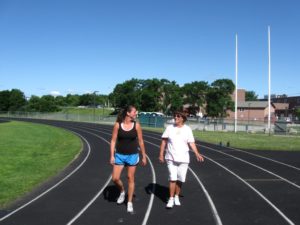 By Wendy Bumgardner
By Wendy Bumgardner
Walking is an excellent exercise for fat burning. While any exercise can burn calories, brisk walking for 45 minutes mobilizes the body to dip into fat reserves and burn stored fat. Walkers can achieve this exercise intensity that uses more fat as fuel.
The Fat Burning Zone
The fat-burning zone is reached when you exercise at an intensity where your heart rate is 60 to 70 percent of your maximum heart rate. In this zone of exercise intensity, 85 percent of your calories burned are fats, 5 percent are proteins and 10 percent are carbohydrates.
The heart rate range for this zone varies by your age. You can use this chart of heart rate zones by age to find the right numbers. You can take your pulse while exercising to check your heart rate. There are also heart rate apps for your cell phone and pulse monitors built into many fitness bands and smartwatches.
The fat burning zone can be achieved with a brisk walking pace. In this zone, you will be breathing heavier, feeling increased exertion, and probably sweating, but you are still able to carry on a conversation. If you find your heart rate is still below 60 percent of your maximum, use these tips for how to walk faster.
How Long to Walk for Fat Burning?
You need at least 45 minutes of walking in the fat-burning zone to get the body to burn stored fat. Walking additional minutes will burn more stored fat.
Fat Burning Walking Workout
Start with a 10 minute warm-up walk at an easier pace. This burns off the stored blood sugar and glycogen energy in the muscles. Pick up the pace to the fat-burning zone of a heart rate of 60 to 70 percent of your maximum.
Continue to walk in the fat burning zone for 30-50 minutes or more.
End with five to 10 minutes at an easier pace for a cool-down.
Fat-Burning Walking Workout: See more tips and techniques for enjoying a fat-burning walk.
When to Do the Fat-Burning Walk
If you enjoy a fat-burning walk five or more days per week, you will achieve the amount of exercise recommended to reduce health risks. The fat-burning zone overlaps with the moderate-intensity exercise zone. You can do a fat-burning walk daily or alternate it with intense workout days.
It you want to lose body fat, you should do a fat-burning workout most days of the week. Walkers who are training for a distance event such as a half marathon or marathon should walk at a pace that is within the fat-burning zone for their long day of distance training each week.
Is Walking Better for Fat Burning Than High-Intensity Exercise?
High-intensity exercise does not burn as much fat for energy as moderate-intensity exercise, but the total calories burned in any workout can help those seeking to lose weight. Walking is a great cardiovascular aerobic exercise that most healthy adults can do without equipment or special training, but it isn’t the only one.
 The best exercise for fat-burning is the one that you enjoy and do daily.
The best exercise for fat-burning is the one that you enjoy and do daily.
Other moderate-intensity exercise activities include bicycle riding on level terrain, water aerobics, easy jogging, elliptical trainer, ballroom dancing, gardening, and doubles tennis. You can mix up your exercise routine and enjoy any of these activities. You can challenge your body in new ways and balance your muscle development by doing a variety of different physical activities.
Tools for Fat Burning
Heart Rate Monitors and Other Ways to Measure Your Heart Rate: To be sure you are exercising a moderate intensity, it is wise to take your pulse as a check. You can take your pulse by hand and use any watch that displays seconds to count your pulse, but a heart rate monitor can give accurate readings continuously.
Walking Shoes: To walk comfortably at a brisk pace and reduce risk of injury, get fitted for the right walking shoes at a serious running shoe store in your area.
running shoe store in your area.
How to Walk Faster: Learn how to use the right arm motion and foot strike to walk briskly and boost your heart rate.
The first step towards burning fat is simply to get moving. Use the quick start walking program to build your walking time, technique, and speed if you haven’t already been walking briskly for 30 minutes or more. Taking it easy at first and working on the basics steadily can get you to your goal.
Source:
Carey DG.”Quantifying differences in the “fat burning” zone and the aerobic zone: implications for training.” J Strength Cond Res. 2009 Oct;23(7):2090-5.

Comments are closed